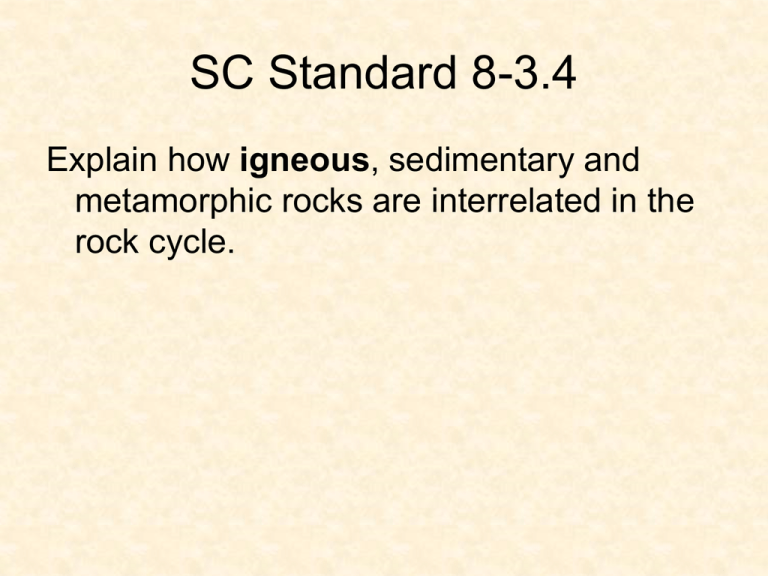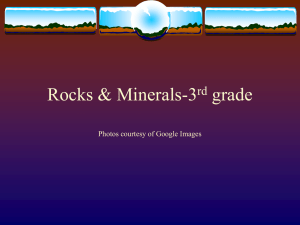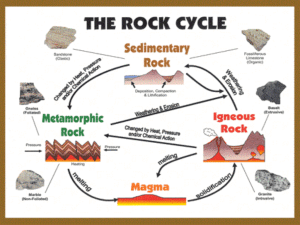8-3.4 Three Types of Rocks
advertisement

SC Standard 8-3.4 Explain how igneous, sedimentary and metamorphic rocks are interrelated in the rock cycle. Rocks • Rocks are naturally occurring combinations of minerals. • Most consist of two or more different minerals. • Rocks are classified according to how they were formed. Physical Properties of Rocks 1. Color (may have a distinctive color for identification) 2. Streak (is the color of the mineral in powered form- shows the true color of the mineral) 3. Hardness (is a measure of the mineral’s resistance to scratching) 4. Luster (property of minerals that indicates how much the surface of a mineral reflects light or if it is SHINY.) 3 TYPES OF ROCKS • IGNEOUS • SEDIMENTARY • METAMORPHIC Igneous Rocks (Volcanoes) • Igneous – means “fire formed.” • IGNEOUS ROCKS: form from lava or magma. (MOLTEN ROCK) – Think of candle wax cooling – Igneous Rocks forms around VOLCANOES… 2 types of Igneous Rocks • When lava is cooled it forms a rock. • When magma cools within the Earth, it also forms rocks. Igneous Rocks (Volcanoes) • Intrusive rock – Igneous rock that formed when magma hardened beneath or inside a volcano. (interior – inside) • Rocks cool slowly – Mineral crystals that form are large – Example: Granite Intrusive: Large crystals – Cools Slowly Igneous Rocks (Volcanoes) • Extrusive rock – Igneous rock formed from lava that erupted from a volcano. (exterior – exit) • Rocks cool quickly – Mineral crystals are small or no crystals are formed – Examples: Basalt, Obsidian • Extrusive: Small crystals – Cools Quickly WHAT TYPE OF IGNEOUS ROCK FORMS IGENOUS ROCKS PROCESSES • Igneous Rocks goes mainly through processes: • 1. Crystallization • 2. Melting • 3. Cooling • 4. Deposition Review 1. Where do igneous rocks form? 2. The only way igneous rocks can form is from the cooling of what? 3. Can a pre-existing rock ever become an Igneous rock? 4. What are the two types of igneous rocks? Explain the difference between them. 5. What are the 2 processes igneous rocks go through? 6. Explain how large and small crystals form in igneous rocks. SC Standard 8-3.4 Explain how igneous, sedimentary and metamorphic rocks are interrelated in the rock cycle. Sedimentary Rocks • Forms near bodies of water or where bodies of water use to be • Sedimentary rocks are made up of sediments. What are Sediments? • Sediment are small, solid pieces of rock, mineral grains, or shell fragments • Sediments are formed through the processes of weathering and erosion of rocks exposed at Earth’s surface. • .These rocks are always forming all around you. Two Processes that make Sedimentary Rocks • 1. Compaction - process that presses sediments together. – At first, the sediment fits together loosely. Over long periods of time the layers build up. – The layers are heavy and press down on each other. • Cementation – process in which dissolved minerals crystallize and glue sediment together. Sedimentary Rocks • Sedimentary rocks usually have fossils within them. • Sedimentary rocks are also known for having layers. Review Questions • Where do sedimentary rocks form? • What are the two processes that sedimentary rocks go through? • How do sedimentary rocks form? • What are sediments? • How do sediments form? SC Standard 8-3.4 Explain how igneous, sedimentary and metamorphic rocks are interrelated in the rock cycle. Metamorphic Rocks • Metamorphic rocks form underneath the Earth’s Surface. • Forms when rocks are changed into different kinds of rocks by great heat and/or pressure • Metamorphic rocks are heated, squeezed, folded, or chemically changed by contact with hot fluids. Metamorphic Rocks Processes • Metamorphic goes through 2 processes: • 1. Heat • 2. Pressure Metamorphic Rocks Classification Classified by the arrangement of the grains that make up the rocks. • Foliated Rocks – Have obvious layers. • Non-Foliated Rocks – Have no visible layers. Foliated or nonfoliated? metamorphism of shale SHALE is the most common sedimentary rock. Through the agents of metamorphism it changes to rocks that are stable at higher temperatures and pressures. These changes take place in the solid state. GRANITE Slate Shale Increasing Temperature and Pressure Phyllite Schist Gneiss Granite (igneous) = GNEISS (metamorphic) Limestone (sedimentary) = MARBLE (metamorphic) Shale (sedimentary) = SLATE (metamorphic) RC (Review Check) • Types of Rocks RC (Types of Rocks Questions) • • • • • • • • • 1. Forms underneath the Earth’s surface 2. Forms around volcanoes 3. Forms near bodies of water or where bodies of water use to be 4. Have fossils within them 5. Goes through the process of cooling, melting, and crystallization 6. Goes through the process of heat and pressure 7. Goes through the process of compaction and cementation 8. Consist of Intrusive and extrusive rocks 9. Can change into other rocks, can be foliated and go through chemical changes • 10. Can go through the process weathering and erosion THE ROCK CYCLE • The rock cycle is an ongoing process. The sample diagram illustrates the series of natural processes that can change rocks from one kind to another:









